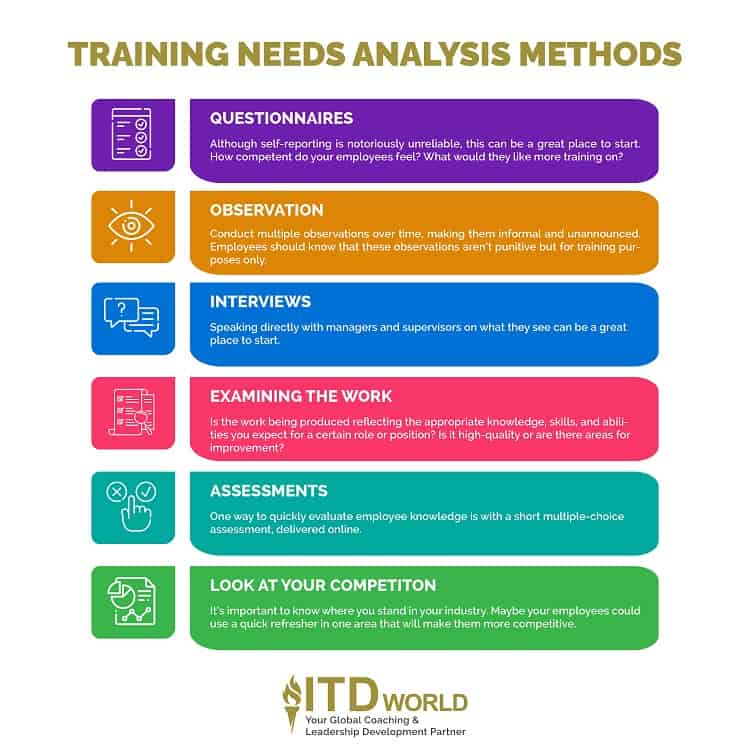Enhancing organizational performance requires more than a mere glance at employee skill sets. That’s where Training Needs Analysis comes in – a strategic compass that helps organizations propel their workforce toward excellence.
|
Author: Jonathan M. Pham |
Highlights
- Training Needs Analysis (TNA) is a systematic process for identifying and prioritizing the skill and knowledge gaps in a workforce to align employee proficiency with organizational goals. It is considered the most critical foundational step in designing effective training programs.
- While Assessment identifies if training is needed (the gap between current and desired results), the deeper Analysis determines how to fill the gap by scrutinizing the underlying root causes and essential elements of the performance disparity.
- TNA ensures training is a strategic investment by aligning initiatives with overall business goals and prioritizing the most critical skills to target. This strategic focus boosts learning efficiency, elevates the effectiveness of HR/L&D efforts, helps measure training ROI, and ultimately improves employee performance and satisfaction.
- TNA is conducted at three interconnected levels:
- Organizational: Aligning training with the company’s strategic vision and overall goals (“Why” is training needed?).
- Group/Job Role: Analyzing the necessary Knowledge, Skills, and Abilities (KSAs) for specific tasks or jobs (“What” training is needed?).
- Individual: Assessing an employee’s current KSAs against the required level and factoring in personal needs/preferences (“Who” needs training?).
- TNA follows a four-stage process: Set the objectives, map out the outcomes (ideal performance), assess performance gaps, and settle on a solution. Best practices include focusing on business results, using a bottom-up approach (involving employees), combining different qualitative and quantitative techniques, and treating TNA as an ongoing, continuous cycle.
What is Training Needs Analysis?
Training Needs Analysis (TNA) is a strategic and systematic examination process typically employed by organizations to unveil disparities existing between the current proficiency levels of their employees and the skills/ knowledge required to meet organizational benchmarks. The purpose is to facilitate the identification and prioritization of training requirements that align with overall business goals/ objectives.
Essentially, TNA is like taking a close look at your workforce’s skills and knowledge, and then figuring out what they need to learn to perform better. It serves as a pivotal foundation for crafting targeted and efficacious employee training initiatives, ensuring that they are finely tuned to the specific needs of the workforce.
Training Needs Analysis Vs Training Needs Assessment
Training Needs Assessment and Training Needs Analysis, while interrelated, are distinct processes in the organizational realm, each playing a crucial role in honing employee performance. The main difference is that the former is focused on identifying the gap between the current and desired results, while the latter also seeks to understand the root causes and essential elements of that gap.
Training Needs Assessment involves a comprehensive examination of the problem/ goal at hand, of the organization, of tasks or jobs, and the learners or employees. It aims to come up with a definitive answer to the pivotal question: “Do we need training?” – and, if yes, some initial insights into what might need to be addressed.
On the other hand, Training Needs Analysis delves deeper into the intricacies of performance gaps – by scrutinizing the underlying elements that contribute to the disparity between current and desired outcomes. This process is pivotal for designing a bespoke training solution that goes beyond resolving surface-level deficiencies, providing a more comprehensive understanding of the learning landscape. Moreover, it also explores the optimal methods, strategies, and resources required – so that the end result is a detailed training plan that outlines learning objectives, target audiences, training formats, content specifics, and delivery methods. Essentially, it answers the multifaceted question of “How to fill the gap?”
| Criteria | Training Needs Assessment |
Training Needs Analysis
|
| Focus | Gap between current and desired results |
Underlying elements of performance gap
|
| Goal | Identify need for training and initial insights |
Design bespoke training solution
|
| Depth | Surface-level | Detailed |
| Output | Yes/No decision on training and initial ideas |
Detailed training plan
|
| Question Answered | Do we need training? |
How to fill the gap?
|
Both processes are symbiotic, working in tandem to produce a plan that lays the foundation for continual employee development and organizational success.
Importance of Training Needs Analysis in the Workplace
TNA is the single most important step in training design.
William Rothwell – Chapter 79, The Encyclopedia of Human Resource Management
- Align training initiatives with overarching business goals
TNA ensures that training programs are not just a routine exercise – but a strategic investment, precisely tailored to address the specific needs of employees while concurrently advancing organizational objectives. This alignment is not a mere formality; research from the Society for Human Resource Management (SHRM) has underscored how a needs analysis serves as a clarifying lens, elucidating the crucial link between required skills and organizational success.
- Spotlight skills and performance gaps
This early detection mechanism allows organizations to intervene promptly, providing targeted training before gaps widen and become detrimental. The insightful exploration of causes and consequences amplifies the effectiveness of these interventions, ensuring a nuanced approach to skill enhancement.
- Target the right skills
By ranking training needs based on factors such as importance, urgency, feasibility, and cost-effectiveness, TNA facilitates efficient resource allocation. This strategic prioritization, on the one hand, helps optimize the utilization of training resources. On the other hand, it ensures clear communication of training needs and recommendations to relevant stakeholders, fostering a collaborative and informed approach.
- Boost learning efficiency
Research from the Harvard Business Review underscores the importance of starting training programs with a needs analysis – particularly, such an approach is proven to significantly enhance learners’ ability to retain and apply acquired knowledge. Thus, TNA is not merely a prerequisite; it is a catalyst for creating training programs that resonate with learners, ensuring lasting impact and application in the workplace.
- Elevate the effectiveness of Human Resource Management (HRM) and Learning & Development (L&D)
Armed with TNA insights, HR professionals may be equipped to strategically focus on specific areas of L&D, tailoring programs to enhance the skills, knowledge, and abilities of employees. This data-driven approach lays a robust foundation for developing training programs that are responsive to evolving skill requirements.
- Measure training Return on Investment (ROI)
The data gleaned during TNA becomes a compass for tracking the impact of training programs, facilitating a tangible assessment of their effectiveness and contribution to organizational development.
- Improve employees’ performance and satisfaction
By delivering training that is not just necessary but also desired, TNA becomes a catalyst for improved performance, heightened productivity, and enhanced job satisfaction. The outcomes ripple across organizational processes, leading to higher quality, reduced errors, expedited delivery, and amplified customer satisfaction.
Moreover, the investment in employee development pays dividends in motivation, engagement, and retention, building up a workforce that feels valued, supported, and empowered.
If learning isn’t connected to the why, it won’t stick.
Mark Marsen – HR Director

When to Conduct a Training Needs Analysis
Proactive:
- Regular intervals: Annually or biannually to pre-empt potential skill gaps and stay ahead of industry trends.
- Organizational changes: New technologies, procedures, or structures require TNAs to ensure smooth transitions.
- External changes: Market shifts, customer demands, regulations, or innovations may necessitate skill re-evaluation.
- Pre-performance review: Leverage review data to identify and address specific competency gaps.
Reactive:
- Performance dips: Individual or team performance declines may require TNAs to diagnose and address skill gaps.
- High employee turnover: Analyze skills gaps contributing to turnover and implement retention-focused training.
- Employee feedback: Validate and respond to employee requests for specific skills or knowledge.
Types of Training Needs Analysis
By focus:
- Organizational: This type analyzes overall organizational goals, objectives, culture, and values to identify training needs aligned with the big picture. It asks “why” training is necessary and ensures alignment with long-term vision.
- Employee: Here, the focus is on individual employees – i.e. assessing their current knowledge, skills, and abilities (KSAs) to identify skill gaps and tailor training programs to their specific needs. It is about “who” needs training, and how to measure individual impact.
By methods:
- Task/job-based: This approach addresses the critical question of what training is needed, providing a granular perspective on the competencies that directly contribute to task success.
- Performance-based: Performance analysis is meant to identify performance gaps attributable to a deficiency in KSAs, unravel the causes and consequences of these gaps, and act as a diagnostic tool for crafting targeted training interventions. It aims to understand “where” are the performance issues and how training may address them.
Additional components:
- Knowledge-based: Breaks down specific knowledge gaps for targeted knowledge acquisition.
- Skill-based: For targeted skill development.
- Ability-based: For refined ability training.
Read more: Employee Skill Development – Strategies for Attaining the Bottom Line
Training Needs Analysis Levels & Components
Organizational level – Strategic analysis
At this level, the focus is on aligning training needs with broader performance metrics and the strategic vision of the organization. This involves a comprehensive examination of the overall organizational vision, mission, objectives, and challenges. Activities include assessing how training can optimize company-wide performance and productivity to achieve organizational goals – by utilizing data sources such as organizational data, market research, industry reports, strategic plans, and insights from leadership.
Resources such as budget, time, technology, and personnel are scrutinized to determine their adequacy for training implementation. The expected outputs are strategic insights into training needs that resonate with the overarching goals of the organization.
Group/Job Role Level – Operational analysis
Here, the focus shifts to identifying specific training needs at the team, department, or business unit level. Here, the analysis hones in on the tasks or jobs relevant to the training goal, as well as the requisite Knowledge, Skills, and Abilities (KSAs) for effective performance. The work environment, including tools, equipment, policies, procedures, and regulations, is also scrutinized. Data sources at this level include task analysis, performance data, job descriptions, observation of workflows, and interviews with managers and employees.
Individual level
At the Individual Level, the analysis zooms in on assessing the current KSAs of learners or employees and the gap between their existing proficiency and the desired level. The focus extends to personal needs and preferences, exploring how training impacts individual performance. Factors such as motivation, attitude, aptitude, and preferences need to be thoroughly assessed.
Data sources include individual performance reviews, skills assessments, self-assessments, career development plans, and feedback from managers and peers. The expected outputs are personalized training recommendations, tailored learning journeys, and opportunities for skill development aligned with individual career goals.
Read more: Aligning Individual Goals With Organizational Goals
Stages of the Training Needs Analysis Process
Stage 1: Set the objectives
This stage serves as the foundational pillar, establishing the strategic direction for subsequent analyses. Here, the focus is on identifying both short and long-term goals for the organization, aligning them with the requisite performance levels needed for accomplishment.
High-level questions are posed to senior management, line managers, supervisors, and employees – e.g:
- What are the organization’s goals?
- What skills will it take to achieve those goals?
- Who in our organization will be working toward achieving those goals?
Stage 2: Map out the outcomes
The objective of this step is to delineate the ideal performance of employees in executing their core job functions. This requires a meticulous analysis of employees’ duties and the skills and competencies imperative for meeting the organization’s business objectives.
The primary questions in this phase are:
- What are the required skills, knowledge, and abilities that employees need to perform their jobs or tasks effectively?
- Will the skills and knowledge change based on the business needs?
Stage 3: Assess performance gaps
This phase involves a comprehensive examination of the delta between existing performance levels and the desired ones. The process combines a review of existing performance data with targeted data collection methods, such as interviews with leaders and line employees, and analysis of company metrics.
Questions typically asked during this phase include:
- What key events or critical decisions led to this point, and how can we improve them?
- What have we done well, and what can be done differently?
Stage 4: Settle on a solution
This stage encapsulates the transition from diagnostic insights to strategic decisions, paving the way for the implementation of targeted training interventions. Here, the focus is on listing down optimal courses of action to address identified gaps.
Key questions include:
- Where would improved skills and knowledge have the biggest impact?
- What are the operational parameters for any training solution?
- What modalities will be most effective based on the content and context?

How to Conduct a Training Needs Analysis
Conducting a successful Training Needs Analysis (TNA) requires a step-by-step approach to ensure you gather the most relevant and actionable insights to inform effective training programs:
-
Define the purpose and scope
- Examine organizational goals, including the overall vision, mission, objectives, and challenges.
- Identify the reason for conducting the TNA – whether to address performance issues, implement new technologies, prepare for organizational changes, or cater to individual development needs.
- Specify the target audience, determining if the analysis will focus on individual employees, specific teams, departments, or the entire organization.
- Set clear and measurable objectives, outlining the skills and knowledge to be assessed.
-
Choose the data collection methods
- Consider factors such as the target audience, desired level of detail, and available resources.
- Utilize formal methods like performance analysis, task analysis, needs assessment, compliance analysis, gap analysis, benchmarking, and cost-benefit analysis.
- Employ informal techniques such as observation, performance appraisals, one-on-one meetings, exit interviews, employee feedback surveys, and focus groups.

-
Gather and analyze data
- Implement the chosen methods effectively, ensuring active participation from relevant stakeholders.
- Organize and categorize collected data, identifying patterns, trends, and themes to pinpoint skill gaps and training needs.
- Prioritize needs based on impact and urgency, considering both individual and organizational benefits.
-
Develop recommendations and action plans
- Establish training needs, and determine solutions like training, coaching, mentoring, feedback, or job redesign.
- Design targeted training programs, tailoring content, format, and delivery methods to address specific needs at each level (individual, team, organizational).
- Create implementation plans, outlining logistics, resources, timelines, and responsibilities.
- Communicate findings and recommendations, sharing TNA results with stakeholders and leadership to secure buy-in and support.
-
Evaluate and improve
- Measure the effectiveness of training programs by tracking performance changes, knowledge acquisition, and skill development.
- Gather feedback from participants and stakeholders.
- Adapt and refine training programs based on evaluation results.
- Integrate TNA into a continuous cycle, regularly revisiting and updating the analysis to ensure alignment with evolving needs and goals.
Example of Conducting a Training Needs Analysis
Scenario: A mid-sized hospital experiences an increased readmission rate for patients discharged after open-heart surgery. The administration suspects insufficient post-operative education is contributing to the issue.
Define the purpose and scope:
- Purpose: Improve post-operative education for open-heart surgery patients to reduce readmission rates.
- Target audience: Patients undergoing open-heart surgery and the nurses responsible for their discharge education.
- Objectives: Enhance patients’ knowledge of medications, wound care, activity limitations, and warning signs requiring medical attention.
Data collection methods:
- Performance analysis: Review readmission rates for open-heart surgery patients over the past year, focusing on readmission reasons related to complications potentially preventable with better education.
- Task analysis: Observe and interview nurses providing discharge education, identifying specific knowledge gaps and challenges in communicating effectively with patients.
- Needs assessment: Survey patients post-discharge to gauge their understanding of instructions, identify areas of confusion, and assess confidence in managing their recovery at home.
Gather and analyze data:
- Analyze readmission data to identify trends and potential areas for improvement in discharge education.
- Observe and interview nurses, taking notes on their communication strategies and challenges encountered.
- Analyze patient survey responses, prioritizing areas with recurring knowledge gaps and concerns.
Develop recommendations and action plans:
- Training needs: Develop a targeted training program for nurses on effective communication techniques, post-operative care protocols, and addressing patient anxieties.
- Training program design: Include interactive modules, simulations, and role-playing exercises to enhance skill development and knowledge retention.
- Implementation plan: Schedule in-person nurse training sessions, designate peer mentors, and provide reference materials for ongoing support.
- Communication: Share analysis results and training plans with hospital leadership, nurses, and patients to ensure alignment and buy-in.
Evaluate and improve:
- Track readmission rates for open-heart surgery patients post-training to measure the program’s effectiveness.
- Conduct follow-up surveys with patients and nurses to gather feedback on the training program and identify areas for improvement.
- Regularly review and update the training based on feedback and ongoing data analysis.

Training Needs Analysis Best Practices
- Focus on business results: Studies by McKinsey have revealed the necessity of aligning training programs with key business performance metrics (KPIs) – so as to ensure relevance and value. Make sure to integrate new training methods within broader organizational processes to maximize impact.
- Take a bottom-up approach: Decentralize the TNA process by involving employees, fostering buy-in, and encouraging ownership of their learning and development.
- Make use of frameworks: Leverage established frameworks like the ADDIE model for a systematic approach to analysis, design, development, implementation, and evaluation. Additionally, consider employing qualitative and quantitative techniques such as gap analysis, SWOT analysis, or statistical analysis to help identify and prioritize training needs.
- Combine different techniques: Utilize a mix of qualitative and quantitative methods to gain a comprehensive understanding of training needs.
- Use multiple methods & sources: Collect data from various sources such as surveys, interviews, focus groups, observations, tests, and performance reviews. On top of that, involve a variety of stakeholders – including managers, supervisors, peers, customers, and stakeholders – to ensure diverse perspectives.
- Maintain data quality & integrity: Implement ethical practices for data collection, storage, and analysis to ensure privacy and confidentiality.
- Shift the role of L&D: Given the rise of self-learning and advancements in artificial intelligence, it is time for Learning and Development people to transform their role from that of an executor to a facilitator.
- Involve Subject Matter Experts (SMEs): Leverage the expertise of relevant individuals to validate findings and guide program development.
- Deploy collaborative, flexible learning platforms: Explore platforms that offer a variety of learning formats, including webinars, articles, virtual classes, and practice environments. The purpose is to provide opportunities for employees to learn anytime, anywhere, and in ways that suit their preferences.
- Prioritize actionability: Align training with job responsibilities to enhance effectiveness. Encourage learning-by-doing in risk-free environments where employees can practice new skills and receive immediate feedback.
- Go broad: Organizations should strive to facilitate skill expansion to retain employees amid high attrition rates. Open up learning offerings – so that team members are equipped to explore new career paths within the company.
- Don’t neglect the interpersonal aspect: As revealed in a study by the Harvard Business Review, businesses are advised to offer interpersonal skills training to enhance team members’ communication, negotiation, empathy, coaching, and cross-cultural communication skills.
- Regularly revisit & update: Treat TNA as an ongoing process rather than a one-time event. Periodically revisit the analysis to adapt to evolving needs, ensuring that training remains relevant and impactful over time.
Additional Resources
- Training Needs Analysis Checklist
- Training Needs Analysis Template
- Training Needs Analysis Questionnaire
Improving Your Training Needs Analysis Effectiveness with ITD World’s Professional Courses
We all know the frustration of training programs that miss the mark. Hours wasted, budgets drained, and little impact on performance. Yet it doesn’t have to be that way. At ITD World, we provide a comprehensive suite of courses designed to help transform organizations’ learning initiatives from costly exercises into strategic investments. Whether we’re seasoned L&D professionals or just starting out, we offer just the perfect roadmap for success!
- The Certified Training Professional (CTP) program lays the groundwork, equipping participants with a rock-solid understanding of TNA methodologies, data collection tools, and gap analysis techniques. By attending the course, you have the chance to learn to identify not just skill gaps, but also motivational and environmental factors that influence performance. This holistic approach sets the stage for truly impactful training interventions.
- The Certified Talent Development & Learning Professional (CTLP) program takes a step further, delving into the strategic alignment of training with organizational goals. The course revolves around how to translate business objectives into concrete learning initiatives, ensuring every investment delivers maximum ROI. By the end, participants may become not just TNA experts, but strategic learning partners, driving organizational success through targeted and effective training programs.
- The Certificate in Instructional Design & Development (CIDD) goes beyond TNA, by empowering you to craft engaging and effective learning materials that directly address identified needs. You’ll learn cutting-edge design principles, explore diverse delivery formats, and master tools to create impactful training experiences that truly drive performance.
Let ITD World be your partner in unlocking the full potential of your workforce – by contacting us for a FREE consultation now!
Final Thoughts
From identifying skill gaps to designing targeted training initiatives, Training Needs Analysis is the linchpin in bridging the divide between current capabilities and future aspirations. Investing in a TNA isn’t just about checking a box; it’s about igniting a fire of learning and growth. By bridging the gap between the current and desired state of the workforce, organizations may have a better chance to empower their team to reach new heights.
Other resources you might be interested in:
- Instructional Design: Models, Principles & Strategies
- Train the Trainer Model: Investing in Excellence
- Training Quotes: Inspirational Words that Motivate Learning & Growth
- Mastering Talent Management: Strategies for Organizational Success
- Talent Development Playbook: Building Your Future Workforce

